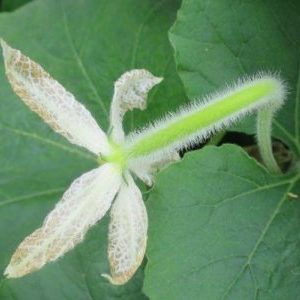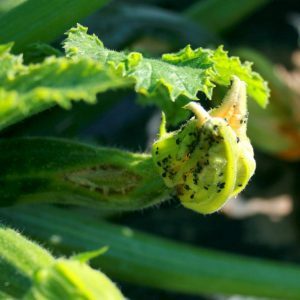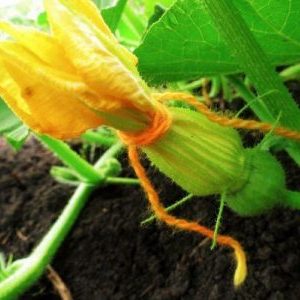Why pumpkin ovaries turn yellow and fall off: determine the cause of the problem and save our harvest
Pumpkin is a picky plant that does not give gardeners a lot of trouble. But it happens that the ovaries on the bushes begin to turn yellow, rot and fall off. If the problem is not dealt with, there is a risk of being left without a pumpkin crop.
Today we'll talk about why pumpkin ovaries turn yellow and fall off, as well as ways to solve this problem.
The content of the article
Causes of yellowing and falling off ovaries
The sources of the problem are very different. The formed fruits turn yellow, rot and fall off due to damp cold weather, weak bush growth, poor soil. The ovaries often fall off when there are too many of them. Let's consider each of the reasons in more detail.
Pollination does not occur
The future fetus is formed from a pollinated female flower. The opened bud has only two days to pollinate. If during this time the ovary is not formed, the barren flower withers and falls off.
Since pumpkins are pollinated by insects, it is less likely to carry pollen from a male to a female in rainy weather.
Little sunshine
Pumpkin belongs to light-loving plants. The reason for the shedding may lie in the lack of sunlight. In the shade, the plant stretches, the inflorescences turn yellow and dry up, the fruits are small.
Little moisture
 Problems at the stage of fruit formation can arise due to insufficient soil moisture.
Problems at the stage of fruit formation can arise due to insufficient soil moisture.
Pumpkin bushes are watered not often, but abundantly, about 1 time per week. After watering, the soil is loosened.
Excess moisture
Excessive moisture is just as detrimental to the future harvest as insufficient. Rotten ovaries are removed, as they become the source of the development of putrefactive bacteria that can infect healthy specimens.
Crop rotation rules not followed
Poor soil also becomes the reason for the falling off of inflorescences. Pumpkin bushes take a lot of nutrients from it, so the same place for a pumpkin patch is used no more than once every 5-6 years. Potassium and phosphorus are especially needed for fruit formation.
Soil is oversaturated with nutrients
Excess fertilizer in the soil is also detrimental to the ovaries. Massive lashes and dense foliage on the bush signal an excess of nitrogen. The plant actively grows green mass and is "lazy" to set fruits.
Pests
 One of the possible causes of yellowed and fallen ovaries is pests, for example, meadow moth. Insect caterpillars harm not only the pumpkin, but also other crops on the site.
One of the possible causes of yellowed and fallen ovaries is pests, for example, meadow moth. Insect caterpillars harm not only the pumpkin, but also other crops on the site.
How to prevent yellowing and shedding of ovaries
If barren flowers are the cause of ovary shedding, artificial pollination with a plucked male flower will help. Male flowers appear on pumpkin bushes earlier than female ones. They recognize them by their long pedicels and stamens.
The best results are obtained by pollination on the first day of the opening of the female inflorescence. They take a male flower, fold back the petals and carefully draw them over the female flowers. The procedure is carried out in the morning, as the buds close in the afternoon.
Choosing the right place for your pumpkin patch is very important. It should be a sunny, high area with no stagnant water. Optimal illumination of plantings - at least 9 hours a day.
When cold and damp weather sets in, pumpkin bushes are covered with a covering material. A delay in plant growth and ovary formation is often caused by a lack of heat.
To prevent the ovaries from spoiling from rot, watering is reduced.During rains, it is good to drain water from the pumpkin bushes.
Attention! For watering pumpkins, choose the evening time when the inflorescences are closed. Then the water will not wash off the pollen, and there will be no problems with pollination.
For the formation of ovaries and the development of fruits, feeding is of great importance. The first time fertilizers are applied after planting seedlings in open ground. The second time is during flowering. The last time the pumpkin is fed is 3 weeks after the second fertilization.
When choosing fertilizers, they are guided by the composition of the soil.
Preventive measures
The successful cultivation of pumpkin is largely determined by the quality of the used seed material... As with the cultivation of any crop, the harvest is laid at the stage of buying and planting seeds.
Selecting large, healthy seeds and preparing them for planting will ensure strong shoots. The landing site is prepared in advance. The soil is dug up and fertilized. If this is not done, the pumpkin bush will not have enough nutrition, and the ovaries will fall off.
For faster formation of fruits, fruit formation stimulants are used, for example, "Gibbersib".
Tips from experienced gardeners
Compliance with the recommendations of experienced gardeners will help prevent yellowing and shedding of the ovaries:
- Pumpkin loves warmth and sun... The sunniest place on the site is chosen for the garden.
- Only warm water is used for watering pumpkin bushes.... They pour it under the root, trying not to get on the flowers and leaves.
- After the pollination process is complete, the pumpkin bush is formed... Removing extra lashes solves the problem of too many pumpkins formed.
- In large-fruited varieties, 2-3 lashes are left per bush and 1 ovary on each lash. In small-fruited, it is enough to remove the lashes without ovaries.
- Timely weed removal on the site will prevent the appearance of pests and diseases.
Read also:
Pumpkin "Winter Sweet", popular among farmers.
The most unusual type of pumpkin "Luffa": what it is.
The benefits and harms of pumpkin juice for men, women and children.
Conclusion
Compliance with the agrotechnology of growing pumpkin prevents problems with the formation of ovaries on the bush and the fall of inflorescences. If the ovaries turn yellow and fall off, artificial pollination, fertilization, and a reduction in the frequency of watering will help correct the situation. Take care of your pumpkins and they will delight you with a rich harvest!